Allow us to introduce you to the stunning Calathea musaica (Goeppertia kegeljanii), also called Calathea Network, a tropical houseplant that looks like a living, breathing work of art.
Its intricate, mosaic-like patterns and prayer-like movements have earned it a spot in the hearts of plant enthusiasts worldwide, and we’re sure you’ll fall head over heels too!
In this comprehensive guide, we’ll cover everything you need to know about Calathea musaica care, from finding the perfect lighting, watering schedule, and humidity levels to mastering the art of propagation.
Plus, we’ll help you troubleshoot common issues, so your prized plant remains happy, healthy, and ready to mesmerize.
Ready to take a deep dive into the captivating world of Calathea musaica? Let’s get growing!
Table of Contents
Calathea Musaica care
History, habitat, and characteristics
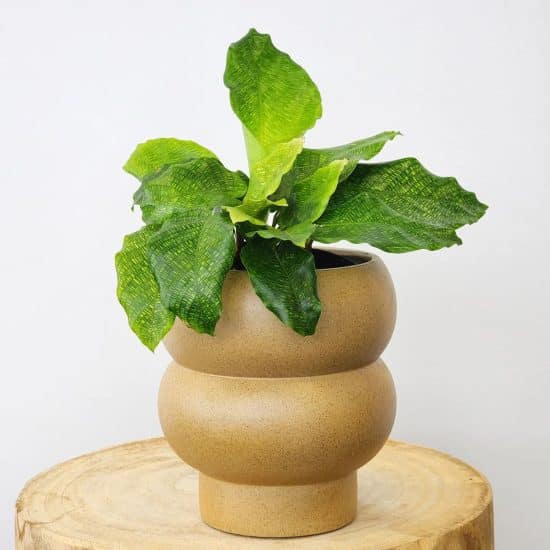
Ever stumbled on a houseplant that looks like it’s straight out of a sci-fi movie? Meet Calathea musaica (Goeppertia kegeljanii), a mesmerizing tropical plant native to Espírito Santo in southeastern Brazil. Part of the Marantaceae family, this quirky species has a truly unique appearance.
It hasn’t always had its current name, though. When William Bull first discovered it in the Brazilian rainforest in 1875, he called it Maranta bella. It was also referred to as Maranta tessellata and Calathea bella before it became known as Calathea musaica, Calathea ‘Network,’ or network prayer plant. Almost as many names as lines on its leaf surfaces!
Speaking of, the intricate, mosaic-like design on Calathea Network’s yellow and green leaves is a total showstopper. And this pattern isn’t just for looks, either: it helps this plant make the most of every bit of dappled sunlight it can get.
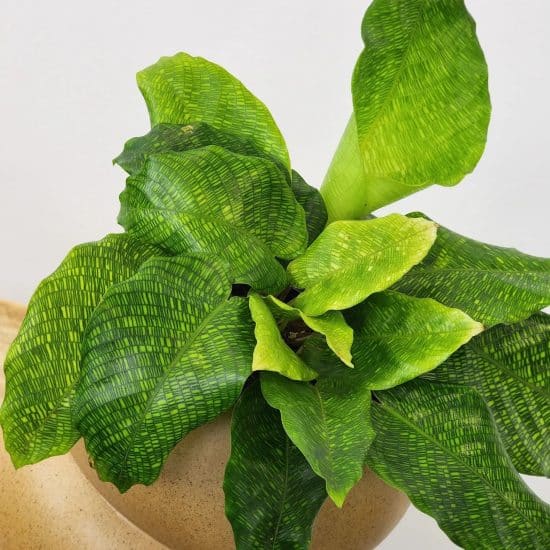
Does it flower indoors? Not often. If it does, you’ll see white, insignificant flowers growing on short stalks. The leaves are really the star here (sorry, blooms).
Once a rare plant, the Calathea musaica has gotten way easier to find after Costa Farms mass produced a smaller, bushier version of it called Calathea ‘Network’ with a thicker mosaic pattern in 2021. (Yep, not quite the same plant, but closely related!).
Better still, its thicker leaves and greater light tolerance make it easier to grow indoors than some of its prayer plant cousins.
Light

So, you’ve got a beautiful Calathea musaica, and you’re wondering how to make its intricate gridded leaves shine . . . What’s the secret? The answer lies in finding just the right amount of bright light to mimic how Calathea musaica grows in the rainforest.
Calathea Network can tolerate greater range of light than its relatives, like the Calathea lancifolia. A gentle touch of warm morning sunlight might actually be beneficial for your musaica! However, you still need to be careful not to overdo it. Too much direct sunlight or overly bright light can cause those gorgeous leaves to curl up, lose color, and get sunburnt with ugly brown spots.
Now, where should you place your plant to give it that perfect lighting? A few feet away from a south or west-facing window, or right up close to an east or north-facing one should do the trick. That way, your Calathea Network gets to enjoy the bright, indirect light it loves without being exposed to harsh sunlight.
What if your Calathea Network isn’t getting enough light? You might notice it growing slowly, leaning towards the light source, or even getting a bit leggy. No worries, though! You can either move your Network plant closer to a brighter spot or use artificial light (like a full-spectrum LED) to give it that extra illumination it craves.
Water
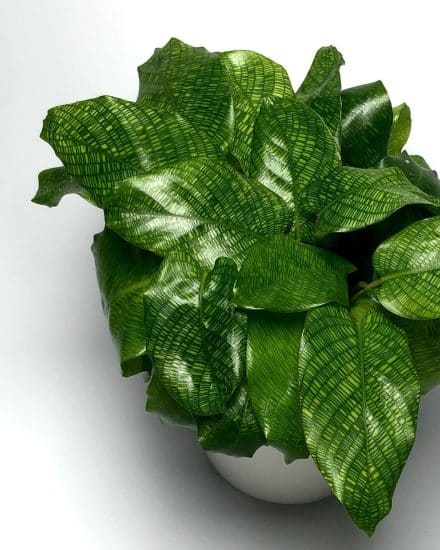
As part of the Calathea family, the Network prayer plant requires particular attention to its watering needs. You’ve got to strike that perfect balance — give it too little or too much water, and you might end up with a sad, wilted plant. How to get it right?
Make sure the potting soil gets almost completely dry between waterings. I know, it’s tempting to water more often, but overwatering can cause yellow leaves and rot (yikes!). On average, you’ll want to water your Network calathea every five to eight days, but always keep an eye on the soil to catch any changes in moisture.
Let’s chat about water quality. See, the Calathea Network has a bit of a fancy taste (like that friend who only drinks bottled water!). It prefers distilled or filtered water, or even rain water, since it’s really not a fan of the fluoride, bromine, and chlorine in tap water. In fact, if you notice brown-tipped leaves, tap water might be the culprit.
Not enough water: If your Calathea musaica plant’s leaves are curling or drooping and the edges turn dry or crispy, it’s probably time to up your watering game. Make sure the Calathea Network’s soil stays nice and moist — but not soggy — to keep it from getting thirsty.
Too much water: Conversely, if you notice yellowing leaves, mushy stems, and soil that’s always wet, your Calathea network might be drowning (no, seriously!).
To fix this, give your plant less water and let the soil dry out a bit more between waterings. When in doubt, remember that it’s usually easier to fix underwatering than overwatering.
Temperature and humidity
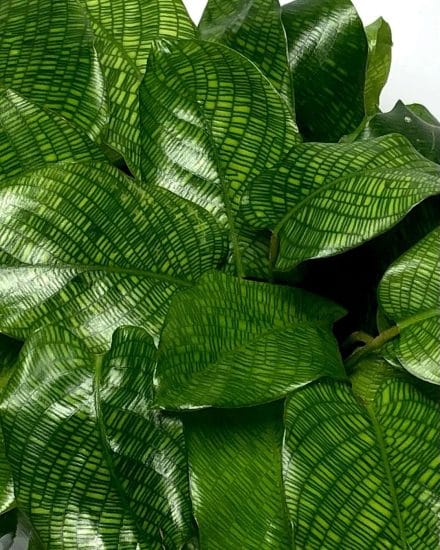
Calathea Network is a tropical plant, so it prefers a warm environment. Aim for temperatures between 65-80°F for optimal growth.
Average room temperature should be just fine, but be cautious of extreme temperature changes, as they can cause your Calathea network’s leaves to wilt. If possible, avoid placing your plant near windows with cold drafts, heating vents, or air conditioners.
While the Calathea musaica plant can tolerate lower humidity better than other prayer plants, in general, the more it gets, the healthier it will be. Calathea musaica can tolerate humidity levels ranging from around 50% (the higher end of typical indoor humidity) to 90% (tropical outdoor humidity).
Keeping humidity levels between 50-65% should be sufficient to create a comfortable environment for your network plant.
Pay attention to your Calathea Network’s leaves, as they can reveal a lot about its overall health. If you notice brown leaf tips or edges, this could be an indication that the humidity level is too low. But you can easily raise it!
Calathea network humidity tips:
- Put your Calathea network on a pebble tray filled with water. The water will evaporate, providing extra humidity around the plant.
- Use a humidifier in the room where your plant is to help maintain a consistent humidity level.
- Stick your network plant next to other plants that have the same high humidity needs so they can share moisture (this is called transpiration).
Soil and planting
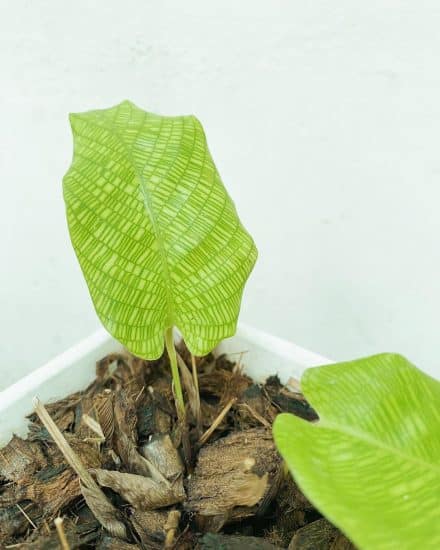
Calathea Network thrives in a well-draining, airy, and nutrient-rich potting mix. It’ll love a forest floor potting mix, which helps mirror ingredients the plant would get in its native habitat, like worm castings, perlite, twigs, bamboo, and worm castings. An aroid potting mix will work well, too.
If your Calathea network is struggling, it could be due to poor soil conditions. You might see yellowing leaves, slow growth, and a generally unhealthy appearance. This can be caused by a mix that is either too dense, poorly draining, or lacking the necessary nutrients.
To fix this, consider adding material that’ll help your mix drain better, like peat moss or coco coir.
Fertilizing
Fertilize your mature Calathea Network lightly, as these plants aren’t heavy feeders. Use a balanced, liquid houseplant fertilizer at half strength every four to six weeks during the growing season (spring and summer). Avoid fertilizing during the winter months when the plant is dormant.
Over-fertilization can harm your Calathea network, causing symptoms like leaf burn, wilting, and stunted growth. If you notice these issues, it’s likely that you’re either using too much fertilizer or applying it too frequently.
The solution is simple: stop fertilizing for a few weeks and monitor your plant’s recovery. If necessary, you may also need to flush the soil with water to remove any excess salts or chemicals. Afterward, gradually reintroduce fertilizer at half-strength and carefully observe your plant’s response.
Repotting
Repot Calathea Network every year or two to encourage healthy growth. The best time for repotting is during the early spring when the plant is actively growing. A plastic or terracotta pot will both work, but remember that plastic pots retain moisture longer than terracotta pots (so maybe not the best idea if you’re a heavy waterer, say).
Choose a new pot that is 1 to 2 inches larger in diameter than the current one and ensure that it has drainage holes. When repotting, handle the plant gently to avoid damaging its delicate roots.
Propagation
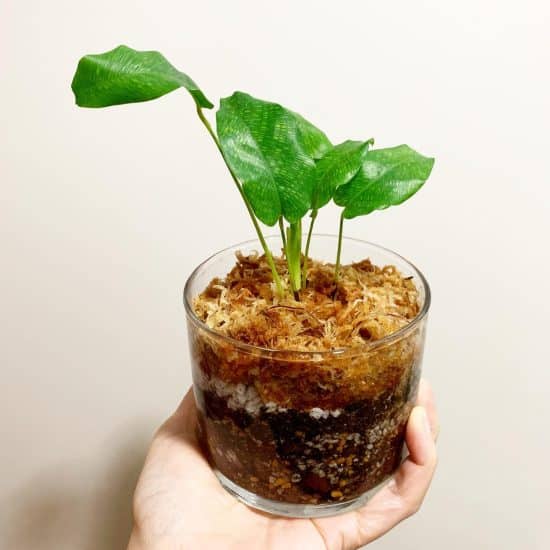
Want to spread the mosaic joy by making more Calathea Networks? Fantastic news! Let’s dive right into the simple process of propagating your Calathea Network through root division.
Propagating Calathea Network by root division:
- Gently wiggle the plant out of its pot: Be super careful when removing your network calathea from its pot. You don’t want to stress out your green friend or damage those precious roots.
- Say hello to the rhizomes: After the plant’s out of the pot, it’s time to take a closer look at the rhizomes – those thick, fleshy, root-like structures that grow underground. They’re like the engine of your plant, so make sure you choose healthy ones for propagation.
- Give those rhizomes some space: Here comes the slightly tricky part. Gently tease the rhizomes apart, doing your best not to hurt the roots or those lovely leaves. If needed, use clean gardening tools to help you, but remember, slow and steady wins the race.
- Ready, set, pots!: Before repotting your new divisions, prepare individual separate pots with a comfy calathea-friendly potting mix. And don’t forget those all-important drainage holes – we don’t want soggy roots, do we?
- Time for the rhizomes’ new homes: Pop each division into a separate pot, snuggling the rhizome just below the soil surface. Make sure each newly separated plant has enough roots and leaves to grow strong and beautiful.
- Give ’em some love and care: Once repotted, place your baby Calathea network plants somewhere with bright, indirect light and treat them to high humidity. Keep the soil nice and moist but not swimming in water.
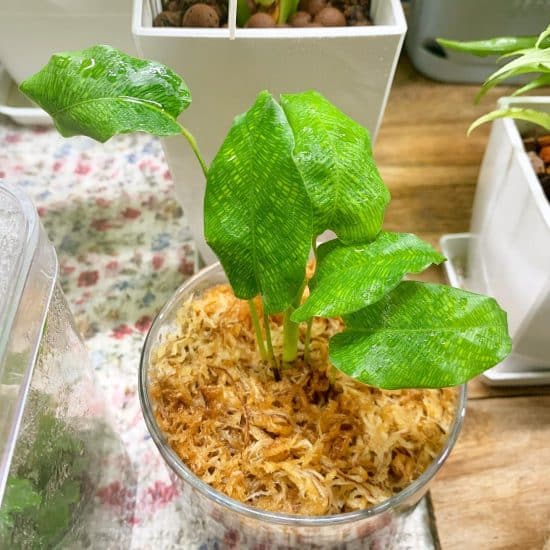
Common issues
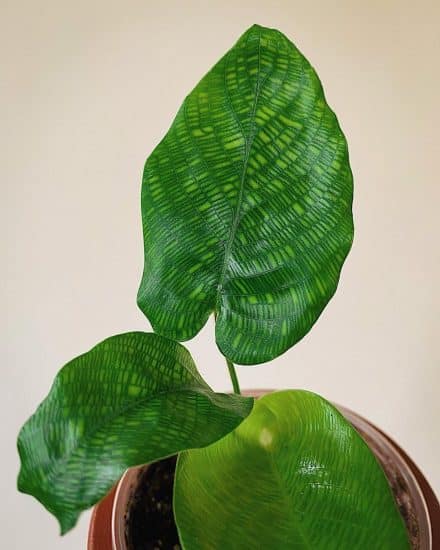
Even the most beautiful plants have their issues, and Calathea musaica isn’t immune either. We’ll help you identify and solve the most common problems that might affect your plant.
Curling leaves

Curling leaves could mean it’s getting too much light or direct sunlight. Keep in mind, Calathea network prefers bright, but indirect light.
Take a look at where your plant is sitting and its light exposure. Is it catching direct sun rays? If so, it’s time to move your plant buddy to a spot with bright, but indirect light. Direct sunlight can be too harsh for its delicate leaves, making them curl up in a sort of self-defense move.
Another thing to check is the soil’s moisture. If it’s constantly dry, your plant might need more water. It’s essential to water your Network calathea evenly and to let the top inch of soil dry out before the next watering. Trust me, your plant will thank you for it!
Yellow leaves
Now, let’s talk about yellow leaves. You see, this could be a sign of overwatering, which can make the leaves turn yellow and fall off … and we don’t want that!
To fix this issue, first assess the soil’s moisture. If it’s too wet, reduce your watering frequency and check that your pot has proper drainage.
If yellow leaves persist, consider repotting your plant with fresh soil and better drainage. Choose a well-draining potting mix and a container with drainage holes to avoid waterlogging. Keep an eye on your watering schedule and adjust as needed, ensuring your Calathea Musaica stays healthy and vibrant. After all, happy plants make happy plant parents!
Pests and diseases

Even though Calathea musaica is generally easy to care for, some pesky problems like bacterial spots, rotting roots, and bugs may still pop up. But don’t worry, we’re here to help you spot, treat, and prevent these issues!
Bacterial spots
You’ll know bacterial spots have invaded your plant when you see dark brown or black spots on the leaves, usually surrounded by a yellow halo. These spots can merge together and cause leaves to wilt … and even fall off!
Solution: To tackle this issue, start by removing all affected leaves using clean, sterilized scissors (alcohol or boiling water works great to clean them). Don’t forget to dispose of the infected leaves carefully to avoid spreading bacteria to other houseplants.
After you’ve done that, go ahead and treat your Network calathea with a copper-based fungicide. Just follow the manufacturer’s instructions and your plant will be on its way to recovery.
Prevention: Keep your plant’s environment spick and span by regularly cleaning up any dead leaves or debris. Also, avoid watering from above, as wet leaves make an inviting home for bacteria. Instead, water your Calathea Network at its base and use well-draining soil to avoid creating a damp paradise for bacteria to thrive in.
Root rot

This usually happens when your plant gets a bit too much love in the water department or has poor drainage. This nasty issue can lead to wilting leaves and a decline in your plant’s overall health. If you notice mushy, slimy, and brown or black roots as well, rotting roots may be the culprit.
Solution: Time for some plant surgery (beats plastic surgery any day)! Gently remove your plant from its pot and snip away any affected roots using sterilized scissors. Next, you’ll want to repot your Network calathea in fresh, well-draining soil. Add some perlite, pumice, or LECA to the mix for extra aeration and drainage, and make sure the new pot has good drainage holes.
Prevention: Practice mindful watering by only giving your plant a drink when the top inch of soil is dry. It’s also a good idea to empty the saucer of any standing water after watering.
You can also try watering your Calathea Musaica from the bottom up, as this helps reduce the risk of root rot. Most importantly, keep an eye on your plant’s roots and make adjustments to your care routine as needed, so you can avoid future root rot fiascos.
Pests
Calathea Network can be prone to pests like mealybugs, spider mites, aphids, and scale insects. You’ll know something’s off when leaves turn yellow, curl, or you see small dots or webbing (spider mites) on the undersides of leaves. Small white bugs or puffs of cotton? Mealybugs. Pear-shaped green or brown bugs and sticky leaf undersides? Aphids.
Solution: First, isolate your plant so the bugs don’t spread. Then spritz it with water to remove as many insects as you can. Finally, use insecticidal soap or diluted neem oil all over the leaves and stems, following the instructions on the bottle. Reapply once or twice after the pests seem to be all gone to get rid of any lurking eggs.
Prevention: Preventing pests isn’t hard – regularly inspect your plant, especially stem and leaf undersides, and give it optimal care. A strong, healthy plant stands less chance of attracting pests in the first place.
Conclusion
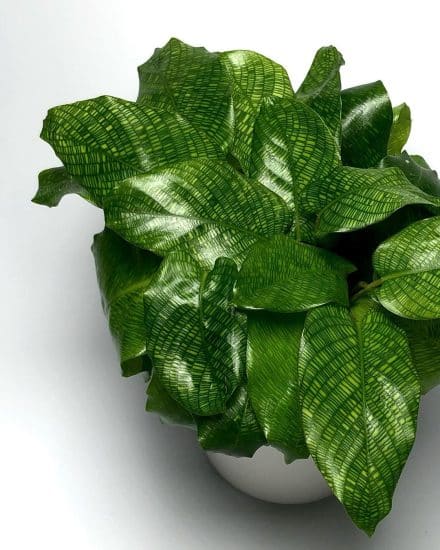
You’ve reached the end of our Calathea musaica (Goeppertia kegeljanii) care guide (congratulations)! With its captivating gridded leaf design, charming prayer-like movements, and Brazilian roots, it’s no wonder this little beauty has made a splash in the houseplant world!
We hope this guide has provided you with all the information you need to successfully grow and care for your Calathea musaica.
If you have any further questions or concerns, please don’t hesitate to reach out to us. Share this guide with fellow plant enthusiasts, and enjoy watching your Calathea plant thrive.
Take care!
FAQ
Is Calathea musaica rare?
Calathea musaica used to be rare, but after Costa Farms mass-produced a version of it called Calathea ‘Network’ in 2021, it’s now pretty easy to find in most plant shops and even big box stores.
Is Calathea Network safe for pets?
Good news for pet parents! Calathea ‘Network’ is considered non-toxic to cats and dogs. However, it’s always best to keep your plants out of reach of curious pets to avoid any potential nibbling or ingestion.
Is Calathea musaica hard to grow?
Calathea musaica plant care can seem challenging, particularly if you’re new to growing calathea plants (our full guide is here). However, it’s considered easier to grow indoors compared to some other calatheas, since it can tolerate a larger range of light and has thicker, hardier leaves.
How big does Calathea Network grow?
On average, Calathea Network reaches a height of around 12 to 18 inches, with a similar spread.


